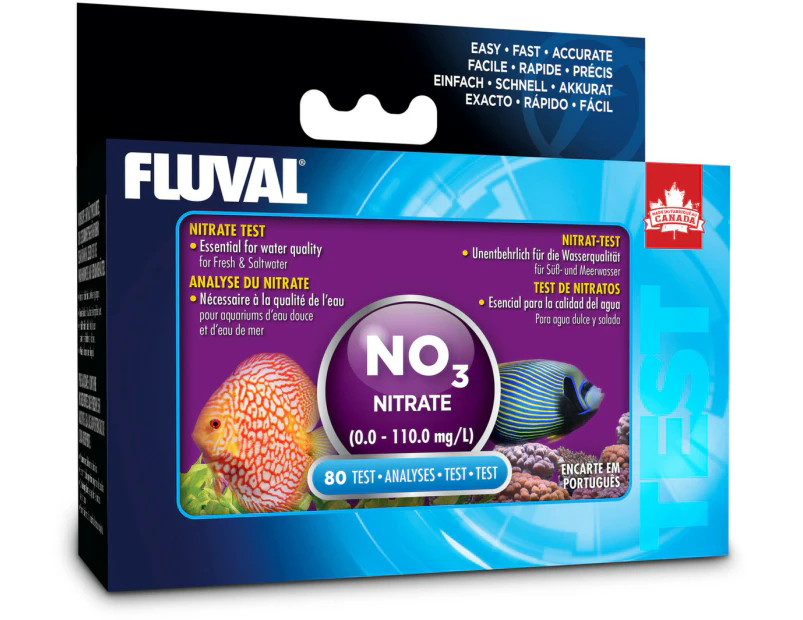Fluval Nitrate Test Kit (80 tests) (A-7871)

Fluval Nitrate Test Kit (80 tests)
- Fast and accurate liquid test to measure nitrate levels in your aquarium
- Essential for optimal water conditions
- Store in a cool, dry place
Accurately measure nitrate levels in your freshwater or saltwater aquarium with the Fluval Nitrate Test Kit. Nitrate is created when nitrite is broken down during the final stage of the nitrogen cycle. High levels of nitrate can lead to algae growth and algae blooms. Test weekly. 80 tests per kit. For freshwater and saltwater.
Kit includes: 1 x NO3 (10.5 ml)
1 x Pipette
1 x Glass test tube
Instruction booklet
WHY ANALYZE NITRATE? Nitrate analysis is important to determine the condition of mature water systems. High concentrations of nitrate suggest an elevated level of pollution in the aquarium and indicate it is time for a partial water change. High levels of nitrate promote the uncontrolled growth of algae. Additionally, several studies have shown that concentrations above 110 mg/L considerably increase stress and reduce the capacity to resist several diseases in numerous species of both fresh and salt water fish. In saltwater, the nitrate toxicity is more pronounced for invertebrates. Saltwater aquariums housing invertebrates should never have concentrations above 20 mg/L.
WHERE IS NITRATE PRODUCED? In a natural environment, nitrate is removed through organic usage. In a closed system, however, nitrate gradually increases over time. This accumulation is due to the fact that it is the final by-product of organic and inorganic degradation. Decay of excess food, feces and dead plant and animal matter are rapidly transformed to nitrate via the nitrogen cycle (nitrification). Overfeeding and/ or overpopulation create an excessive production of nitrate which can destabilize a fragile aquatic system. Always feed with a food that has a high level of digestibility such as Fluval Bug Bites Premium fish food. Never overstock the aquarium. In many cases, a partial water change is an effective way to control high concentrations of nitrate. Ensure that the replacement water does not have high levels of nitrate to begin with.
HOW DOES THE TEST WORK? 1. Take a sample of the water to be tested with the pipette. Use it to fill a clean test tube to the 5 mL line.
2. Add 5 drops of Reagent #1 and 5 drops of Reagent #2 to the test tube. Insert cap. Hold in place with finger and shake well to mix. Attention! Always use the cap. Avoid skin contact.
3.Shake the Reagent #3 bottle vigorously (30 sec.) Tilt the reagent bottle with a 45o angle, add 3 drops to the test tube. Insert cap. Hold in place with finger and shake well to mix.
4. Wait 5 minutes for color to develop, shake again, and match the test color to the closest color on the chart. (No color development means 0 mg/L). For best results, hold the test tube flat against the paper and read with a light source behind you.
5. After use, rinse the tube with fresh tap water to ensure it is clean for next use.
*HIGH LEVELS OF NITRITE WILL INTERFERE WITH NITRATE READING.
EVALUATING THE RESULTS In normal start-up conditions, nitrate appears after a few weeks, following the natural maturation process and establishment of a functioning biological filter. The bacterial population responsible for nitrification (oxidation) of ammonia to nitrite and finally to nitrate requires time to establish.
>50 mg/L
When the nitrate concentration is above 50 mg/L, perform a 20% water change. Use Tap Water Conditioner in the replacement water to reduce fish stress (patented process), remove chlorine and chloramine, and neutralize heavy metals. If in doubt, test dechlorinated municipal tap water for nitrate concentrations before performing the water change. Slowly add replacement water to avoid fluctuations in other water characteristics. Add a regular dose of a Biological Filter Supplement to invigorate and supplement the biological filter.
Nitrate is a vital compound for living plants. Aquarium plants naturally incorporate a large percentage of available nitrate into their systems.
For saltwater systems containing invertebrates, perform a 20% water change when nitrate levels reach or exceed 20 mg/L. For saltwater systems that do not contain invertebrates, follow the freshwater guidelines.
Nitrate removal is also realized through the process of denitrification. This biochemical action is performed by some bacterial strains. They degrade nitrate to nitrogen gas. This proceeds in the absence of oxygen (anaerobic conditions), a condition difficult to obtain or control in most standard aquarium installations. There are a number of denitrification systems that can be useful in the marine environment, but they are often quite expensive.
‘Don’t Pay’ is the recommended retail price provided by the supplier or obtained from the manufacturer, or is the recently advertised price for the same product on a different or competing online platform or store. Catch may not have previously sold the product at the ‘Don’t Pay’ price.
